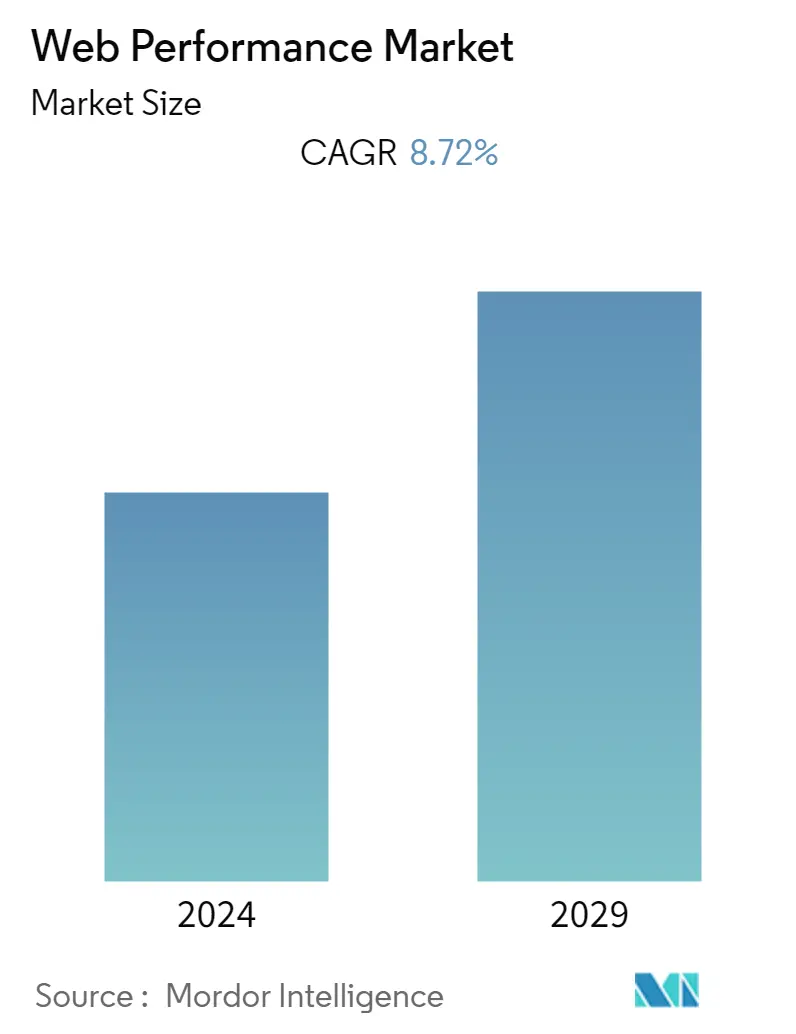Market Size of Web Performance Industry

| Study Period | 2019 - 2029 |
| Base Year For Estimation | 2023 |
| CAGR | 8.72 % |
| Fastest Growing Market | Asia Pacific |
| Largest Market | North America |
| Market Concentration | Medium |
Major Players
*Disclaimer: Major Players sorted in no particular order |
Need a report that reflects how COVID-19 has impacted this market and its growth?
Web Performance Market Analysis
The Web Performance Market is expected to register a CAGR of 8.72% over the forecast period from 2021 - 2026. In the present technological world, customers are expecting fast and reliable online user experiences from every website. If the user waits for the page to load, they'll most likely visit another website instead, as they have limited time to wait for the website to load. Website performance is incredibly essential because customers generally think load times are slower than they are. This means there is a raising need for various organizations to deploy web performance optimization solutions for the website load as fast as possible. If the business is run entirely on the web, performance is crucial, and if the site's user experience is fast and responsive to user input, it can only serve the business well.
- Web performance plays a significant role in the success of any online venture. Here are some instances that show how high-performing sites retain and engage users better than low-performing ones. Pinterest reported an increased search engine traffic and sign-ups by 15% when they decreased perceived wait times by 40%. COOK, a provider of medical devices, increased conversions by 7%, reduced bounce rates, and increased pages per session by 10% when they decreased average page load time by 850 milliseconds. The BBC found they lost 10% of users for every second their website took to load. DoubleClick by Google reported that 53% of mobile site visits were exited if a page took longer than 3 seconds to loaded and also, it was found that sites loading within 5 seconds had 70% longer sessions, 25% higher ad viewability and 35% lower bounce rates than sites taking almost four times longer at 19 seconds.
- Retaining users is crucial to improving conversions. Slow websites have a negative impact on revenue, and the opposite is also true. Here are some instances of how performance has played a role in making businesses more or less profitable. For Mobify, a technology company, every 100ms delay in homepage load speed resulted in a 1.11% increase in session-based conversion, resulting in an average annual revenue increase of almost USD 380,000. Also, a 100ms decrease in checkout page load speed amounted to a 1.55% increase in session-based conversion, which resulted in an average annual revenue increase of nearly USD 530,000. DoubleClick reported that publishers whose sites loaded within five seconds earned up to twice as much ad revenue than site loading within 19 seconds.
- As mobile users continue to become a more substantial portion of internet users worldwide, it's essential to bear in mind that many of these users access the web through mobile 5G, LTE, 3G, and even 2G networks. The decreasing cost of prepaid data plans makes access to the internet more affordable in locations where it once wasn't. According to the Backlinko analysis of 5.2 million pages, the average desktop Time to First Byte (TTFB) speed is 1.286 seconds on desktop and 2.594 seconds on mobile. The average time it takes to load a web page entirely is 10.3 seconds on desktop and 27.3 seconds on mobile, which translates that the average web page takes 87.84% longer to load on mobile vs. desktop. The deployment of web performance solutions could enhance the mobile user's experience of accessing websites of individual enterprises website.
- With the outbreak of COVID-19, technology departments across the globe are grappling with surging demand and mounting pressures to accelerate digital transformation strategies. According to a survey from AppDynamis, 81% of the technologists believe that managing spikes in website traffic is the biggest challenge in delivering seamless customer experiences during the pandemic, which could augment significant growth web performance solutions. A surge in traffic can increase IT costs, especially bandwidth and compute consumption, as they are often optimized for different ranges. Deployment of web performance solutions can reduce costs and serve most, if not all, of the static resources to reduce bandwidth and computation costs.
